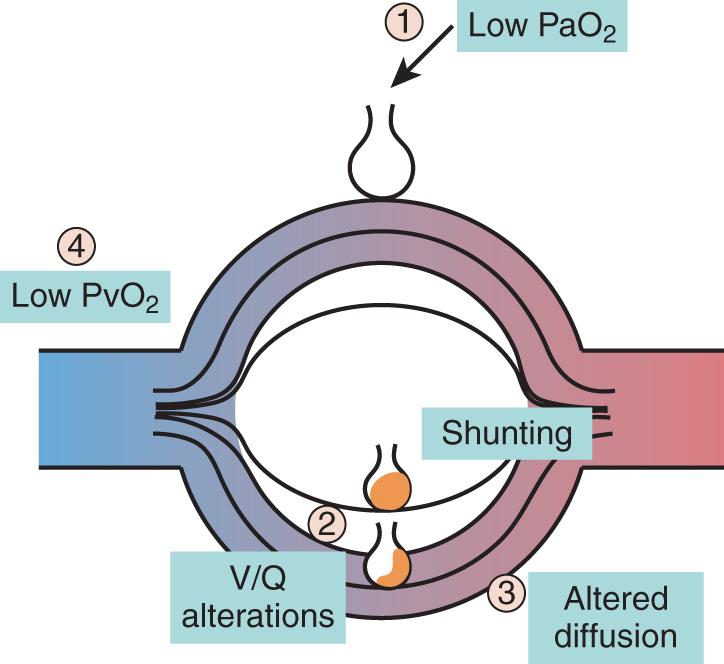Physical Address
304 North Cardinal St.
Dorchester Center, MA 02124
Normal cell function requires an adequate oxygen supply. Lack of oxygen at the cellular level is called hypoxia. Oxygen delivery (DO 2 ) to the tissues is determined by cardiac output and the arterial oxygen content, which in turn is determined by the hemoglobin concentration and its oxygen saturation. Hypoxemia is defined by a significantly low partial pressure of oxygen (PaO 2 ; less than about 75 mm Hg), regardless of the inspiratory oxygen fraction (FiO 2 ). Hypoxemia can be compensated for by an increase in cardiac output, so that DO 2 may not be critically reduced by its presence. The increase in cardiac output that accompanies hypoxemia is mediated by an increase in sympathetic tone, resulting in combined increases in heart rate and contractility. Impaired O 2 delivery to the tissues is more often the result of decreased cardiac output or altered vascular tone than of a decrease in PaO 2 . Tissue hypoxia is a hallmark of shock and is associated with altered cellular metabolism that results in increased blood lactate levels. To avoid confusion, the word hypoxia should not be used to characterize a low PaO 2 .
Hypoxemia is almost always the result of respiratory failure, but it can also be the result of cardiac abnormalities. A low cardiac output can aggravate hypoxemia via a reduction in oxygen saturation of the mixed venous blood (SvO 2 ) (see later). Moderate hypoxemia must be compensated for by an increase in cardiac output, which may be poorly tolerated in frail patients. When that compensatory mechanism is exhausted or when there is concurrent anemia, hypoxia can develop and result in multiple organ failure and cardiac arrest.
The nonlinear relationship between SaO 2 and PaO 2 is affected by body temperature, partial pressure of carbon dioxide in arterial blood (PaCO 2 ), pH, and 2,3-diphosphoglycerate concentration ( Fig. 8.1 ). As a result, patients can have a higher or lower SaO 2 for a given PaO 2 , depending on the existing conditions. The critical PaO 2 value is approximately 60 mm Hg, because a further decline in PaO 2 results in a steep fall in SaO 2 .
Although PaO 2 reflects pulmonary function, it must be related to FiO 2 when judging oxygenating efficiency. (The PaO 2 /FiO 2 ratio is one indicator commonly employed for that purpose.) The SaO 2 is the primary determinant of oxygen content and strongly influences DO 2 . (Dissolved oxygen is a negligible fraction of the total oxygen transported per milliliter of blood.) Thus, giving supplemental oxygen to increase PaO 2 to supranormal levels does not appreciably increase DO 2 and is generally inadvisable except in the context of life-threatening anemia. Nevertheless doing so may have marginal utility if used immediately before interventions that may result in hypoxemia, such as endotracheal intubation or bronchoscopy.
PaO 2 and SaO 2 are measured by arterial blood gas analysis, which requires invasive sampling and is not performed continuously. Capillary blood oxygen saturation (SpO 2 ) can serve as a surrogate measure of SaO 2 and can be measured noninvasively and continuously with a pulse oximeter. Pulse oximetry uses spectrophotometry to detect oxyhemoglobin (peak absorption at 940 nm) and deoxyhemoglobin (peak absorption at 660 nm) via a pulsatile optical signal directed through tissue, with their ratio reflecting the SpO 2 in that tissue (e.g., fingertip or earlobe). However, this measurement can be affected by various factors. The SpO 2 may give a falsely low indication of the SaO 2 if there is poor pulsatility of the waveform: for example, in the presence of altered cutaneous perfusion. Light transmission through the tissues of the fingertip can be decreased by dark nail polish, again affecting that measurement. Methemoglobinemia can also result in a falsely low SpO 2 reading, whereas carboxyhemoglobinemia can result in a falsely elevated SpO 2 reading.
Another issue with pulse oximetry, notably in critically ill patients, is that it takes many seconds for the SpO 2 to reflect acute changes in PaO 2 , including those occurring as a result of alterations of oxygen administration and/or positive end-expiratory pressure (PEEP). Response times are even more prolonged when there is reduced cardiac output. ,
Causes of hypoxemia can be categorized into four groups ( Fig. 8.2 ).

According to the alveolar gas equation, the alveolar PAO 2 is determined by:
where FiO 2 is the concentration of inspired oxygen, P atm is the atmospheric pressure, PH 2 O is the partial pressure of water (typically 47 mm Hg at ambient temperature), and RQ is the respiratory quotient , (i.e., the amount of oxygen consumed relative to the amount of carbon dioxide produced when nutrients are metabolized). RQ is generally assumed to be 0.8, although it may vary. Under normal conditions at sea level,
The first part of the equation can be affected by altitude because P atm decreases. The second part of the equation is primarily affected by PaCO 2 , which typically results from hypoventilation (e.g., central respiratory depression, neuromuscular weakness). Hence, unless there is an increase in the concentration of inspired oxygen, PAO 2 can decrease in the presence of an increased PaCO 2 , which in turn is determined by the following equation:
Thus PaCO 2 can rise with an increase in CO 2 production (increased metabolism), a decrease in minute ventilation (e.g., because of central respiratory depression or neuromuscular weakness), and/or an increase in dead space ventilation.
Become a Clinical Tree membership for Full access and enjoy Unlimited articles
If you are a member. Log in here